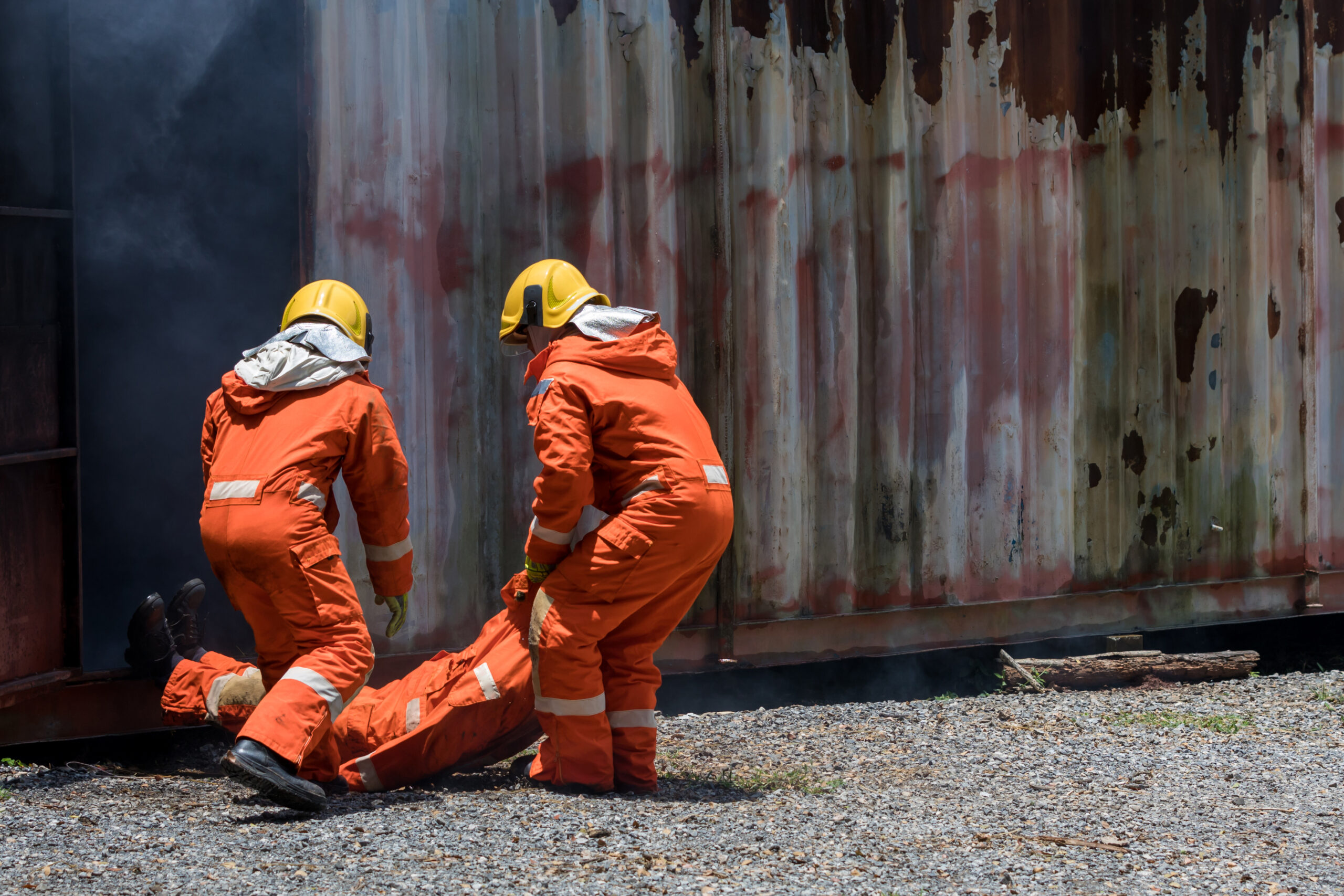Guide to Navigating Safety Audits

Safety audits are structured processes that evaluate how effectively your organization’s safety programs, procedures, and systems function. Think of this as a health check for your safety management system (SMS). The primary objective is identifying gaps, ensuring compliance, and driving continuous improvement. Audits also show employees that leadership is invested in their safety, fostering greater trust and engagement.
Whether you are an auditor or an auditee, approach the audit as a collaborative journey. This attitude demonstrates proactivity and creates a powerful shift from safety as compliance to safety as a shared value.
Understanding the Purpose and Scope of Safety Audits
Regular audits are a tool for creating a stronger safety culture. When done right, they lead to tangible improvements. The scope can range from department-level audits focusing on specific hazards to company-wide assessments evaluating the entire safety management system.
A thorough audit looks beyond paperwork and checks whether procedures are followed on the floor where risks are real. For example, if a routine safety audit uncovers inconsistent use of machine guarding on certain equipment, the issue is not negligence but a lack of clarity in maintenance procedures.
By updating those procedures and retraining staff, the facility will better understand ways to reduce machine-related injuries.
Types of Safety Audits
Safety audits generally fall into three categories. Each type serves a unique purpose, but together, they provide a holistic view of your organization’s safety and health:
- Compliance audits: Compliance audits focus on whether your organization meets applicable laws, regulations, and standards. For example, ensuring OSHA-required training records are complete or that equipment is properly tagged out.
- Program audits: Program audits evaluate specific safety programs like lockout/tagout (LOTO), confined space entry, or hazard communication for effectiveness.
- Management system audits: Management system audits take a broader view, assessing whether your organization’s entire SMS aligns with frameworks like the International Organization for Standardization (ISO) 45001 or the American National Standards Institute (ANSI) Z10 for Occupational Health and Safety Management Systems.
Preparing to Navigate the Safety Audit for Auditors
The key to preparing for a safety audit is to approach it as an opportunity to strengthen your safety culture and uncover meaningful improvements. Preparation is about readiness, transparency, and engagement, which starts with having the right mindset.
Here is a guide to strategically navigating this process.
1. Understand the Scope and Objectives
Schedule a kickoff meeting with leadership and key stakeholders to align expectations and communicate the audit’s purpose. Ask for, or review, the audit criteria in advance so there are no surprises. This proactive approach sets a collaborative tone rather than a defensive one. It also allows you to clearly define what the audit will cover according to the type of audit you are conducting. Knowing the scope helps you focus your preparation efforts.
2. Gather and Review Documentation
Ensure that relevant safety documentation, like policies, procedures, training records, and inspection logs, is organized, current, and accessible. These documents should reflect what is happening on the ground.
For example, you could conduct a warehouse audit and find that while the written forklift safety procedure is solid, operators have not had training on the latest version. Seeing this before the audit lets the environment, health, and safety (EHS) staff close the gap and demonstrate proactive management.
3. Engage Frontline Teams
An audit assesses paperwork and workplace practices. Engage supervisors and employees early by explaining what the audit involves, why it matters, and how they can participate in walk-throughs or interviews. Communicate that the goal is improvement and prioritize transparency to foster trust. You can also conduct informal pre-audits or mock inspections with frontline teams to build confidence and reveal gaps in understanding before the formal audit.
4. Walk the Site Through an Auditor’s Lens
Do a physical walk-through of your facility as an outsider would. Look for things that may be overlooked day-to-day, like blocked exits, missing labels, or incomplete personal protective equipment (PPE) compliance. This can extend to missed updates to Occupational Health and Safety Administration (OSHA) mandates for properly fitting PPE and other nuances.
For example, a facility’s EHS manager could catch a missing emergency light during a pre-audit walk. It is easy to fix and critical for NFPA 101 code compliance.
5. Prepare for Interviews
During the audit, employees at different levels will be interviewed. Focus on helping them build confidence in your processes.
Prepare employees by ensuring they understand that they do not have to know the answer to each question. If unsure, they should always answer honestly and point out where they would go for information.
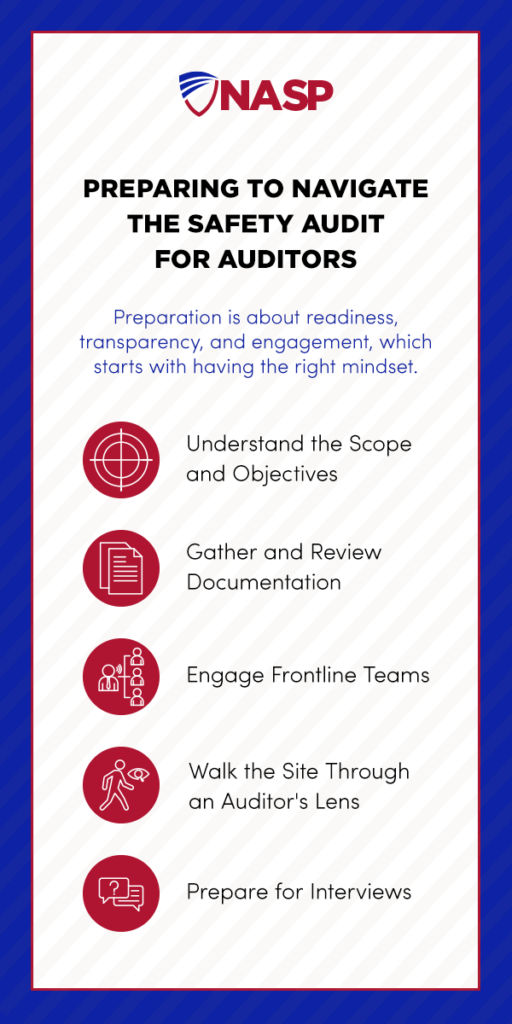
Avoiding the Common Pitfalls
Preparing for and navigating a safety audit is about confidence, collaboration, and a commitment to continuous improvement. Investing in audit readiness is the start to increasing compliance and strengthening your safety culture. It turns the audit from a hurdle into a strategic advantage. Here are some common pitfalls you can plan to avoid:
- Scrambling last-minute: Waiting until audit week to review documentation can lead to oversights and additional stress. Bypass this by making audit readiness a continuous process, not an event.
- Focusing only on compliance: An audit is about operational effectiveness. Focus on balancing compliance with practical assessments of how safety systems work day-to-day.
- Overpreparing employees: Pushing employees to be prepared with the right answers can backfire, creating mistrust with auditors and management. Help employees understand the ‘why’ behind safety practices, which will help them answer authentically.
- Neglecting to follow up: The audit is only the start of improvement. Build a structured action plan to address findings and communicate progress to all levels of the organization.
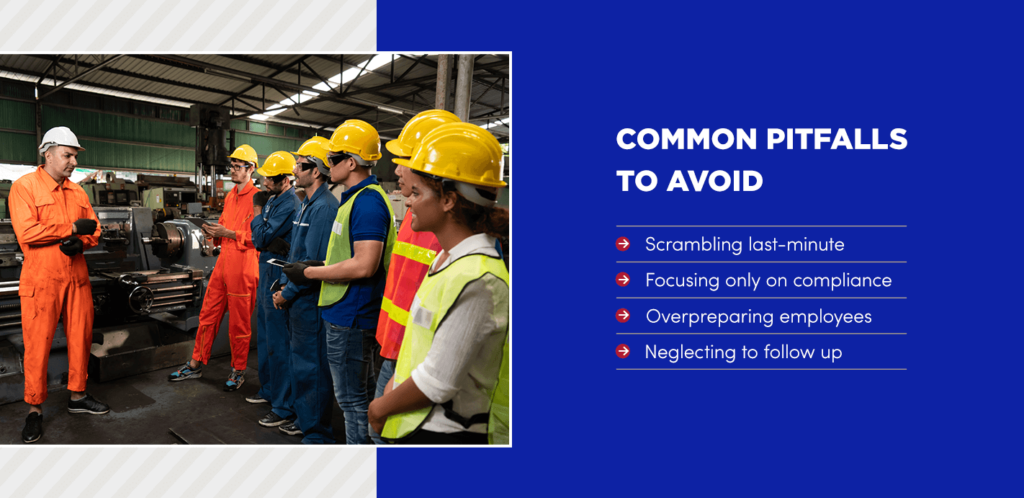
Navigating the Safety Audit Process for Auditees
Navigating the audit process requires an understanding of the following roles, responsibilities, and collaboration strategies.
Who Is Consistently Involved in the Audit Process?
The audit team leads the evaluation process, conducts reviews, site visits, and interviews, and provides findings and recommendations while maintaining objectivity. The auditee is your organization’s representative.
This person or team provides access to documentation, personnel, and facilities. They clarify information and collaborate on corrective actions after the audit.
What Auditees Can Expect From Each Stage
This process typically unfolds in several stages. Here are the steps of a successful safety audit:
- Opening meeting: The audit team outlines the audit plan, scope, schedule, and expectations. This is your opportunity to clarify roles and align on logistics.
- Document review: Auditors review policies, procedures, records, and reports. Be prepared to explain how documents connect day-to-day practices.
- Site walk-throughs: Auditors observe operations, check conditions, and talk with employees to verify that processes work as they need to.
- Preliminary findings: The audit team shares observations and preliminary findings. This is a final chance for the auditor and auditee to ask clarifying questions and provide context.
- Final report: The audit concludes with a formal report and recommendations. The real work starts here — reviewing findings, prioritizing actions, and communicating the next steps.
How to Communicate and Collaborate Effectively
Communication and collaboration are between the auditor, the auditee, and employees who are not directly involved in this process. Auditees can be proactive by designating specific individuals to coordinate documentation, guide safety audit site tours, and answer questions to avoid scrambling in the moment. It is also good to show responsiveness with auditors, which strengthens trust.
If the auditor flags a missing document that you know exists, get the document. If you disagree with a finding, ask clarifying questions to ensure all parties understand how the auditor reached that conclusion.
Also, remember to debrief with employees after the audit to share what went well and what needs work. This is another level of transparency that keeps communication open and encourages continuous engagement from team members.
Following Safety Audit Best Practices and Techniques
For EHS professionals involved in audits, following proven techniques and best practices can make the process more effective, collaborative, and impactful.
Follow these best practices:
- Stay evidence-based: An audit is a fact-finding mission. Focus on verifying compliance and evaluating system effectiveness through documented evidence and direct observation. Avoid assumptions or opinions that are not grounded in evidence.
- Balance breadth and depth: Dig deeper in high-risk areas where the potential for harm is the greatest. Prioritize your time and attention on critical operations rather than spending equal time everywhere.
- Use checklists as a guide: A well-designed hazard identification checklist ensures consistent coverage of regulatory and policy requirements. But you should also go beyond the list, looking for underlying issues like informal workarounds or cultural norms.
- Look beyond the physical: Watch for behavioral and cultural indicators, like whether employees intervene when they see an unsafe act or whether safety gear is worn even when no supervisor is present.
- Communicate consistently: Keep communication with the auditee open before, during, and after the audit, asking clarifying questions where necessary.
- Observe work: Observe tasks in progress, watching for informal practices, shortcuts, or deviations from written procedures. Also, ask employees about their processes. Their explanation can reveal gaps or misunderstandings.
- Take photos: When you are allowed, take photos to provide clarity and objectivity in the final report.
Analyzing Audit Findings and Developing Corrective Actions
A good starting point is to look beyond the safety audit checklist and prioritize the findings that need attention foremost. Each finding should be evaluated for two things:
- The likelihood of an incident happening
- The potential severity if it does
This risk-based approach helps you assess what needs to be addressed first instead of tackling everything at once. Any issues that are highly likely to occur or would have serious implications if they happened should get immediate attention. Lower-risk issues can be addressed later and monitored in the meantime.
Aim for solutions that eliminate the hazard first. If that is not realistic, look at engineering controls, then administrative controls, and personal protective equipment that could positively impact your facility.
Loop in the people who work closest to each hazard when developing solutions. They often have insights into practical fixes or unintended consequences. They will likely be able to shed light on different facets of the situation you had not thought about or were not clued into.
Once corrective actions are identified, assign clear responsibilities and deadlines to keep your team accountable and follow up to avoid potential issues slipping through the cracks.
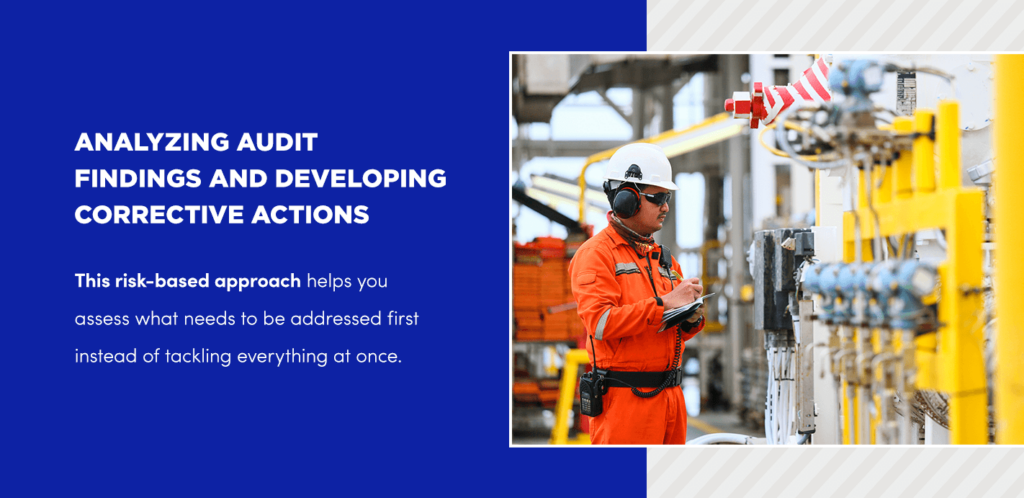
Following Up and Maintaining a Culture of Continuous Improvement
Once the audit is done and corrective actions are identified, the real work begins. Following up is about making sure fixes are sustainable and effective. Both auditors and auditees have a role to play in keeping this momentum going and fostering a culture of continuous improvement.
Tracking is critical. Log every corrective action in a system that is accessible and transparent. Track what needs to be done, who is responsible, and by when.
To really instill continuous improvement, connect corrective action to ongoing training. Use findings to refresh training, clarify expectations, and review procedures. Sharing updated findings is part of a feedback loop that helps prevent the same issues from cropping up again.
Make space to recognize and share improvements, too — when teams see their input or actions led to a safer process, it reinforces buy-in. Audits should spark conversations alongside corrections to leave proactive, lasting improvements.
The Key to Effective Audits
Conducting an effective audit requires more than a checklist — it demands critical thinking, technical knowledge, and communication skills. That is where targeted training makes a difference. Professionals who complete a certified safety management course with andragogical, interactive, and dynamic training methods gain the skills to:
- Identify obvious and hidden hazards.
- Evaluate compliance and operational effectiveness.
- Ask the right questions during interviews.
- Write actionable, prioritized recommendations.
At its core, a safety audit answers key questions. Are your processes aligned with regulatory standards? And, most importantly, are they keeping people safe? Well-trained auditors know how to conduct a safety audit by spotting issues, helping teams understand why they need change, and offering guidance on how to make changes stick.
In a field where small oversights can lead to major legal, operational, and personal safety consequences, investing in auditor training is essential to fuel your proactive safety culture.
Enjoy a Practical Approach to Workplace Safety With NASP
NASP offers professional certifications, online training, classroom training, site-specific training, and a range of safety and environmental consulting services. Our courses are built by safety professionals, for safety professionals, and are IACET-accredited. We also conduct the audit with mock OSHA inspections to help your team improve workplace safety and audit preparation.
At NASP, we have you covered with safety audits. Take our Certified Safety Manager (CSM) course today, or contact us for more information about our offerings.
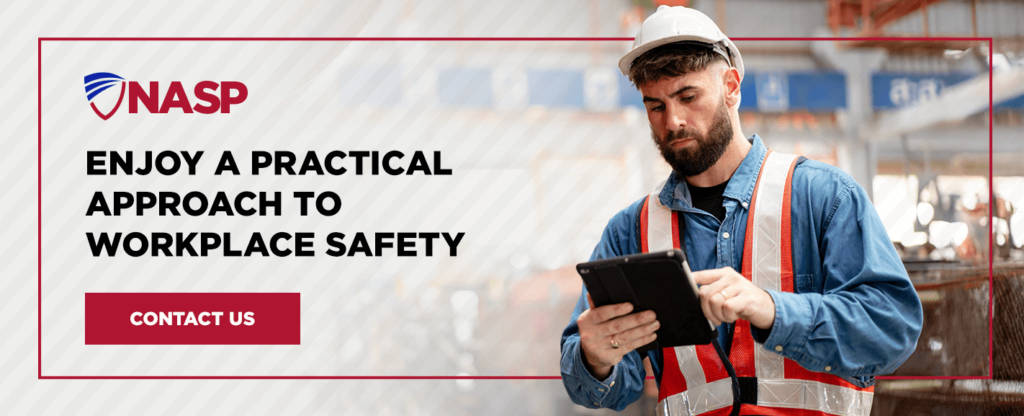
Blog Posts
Latest Posts
Related Posts



